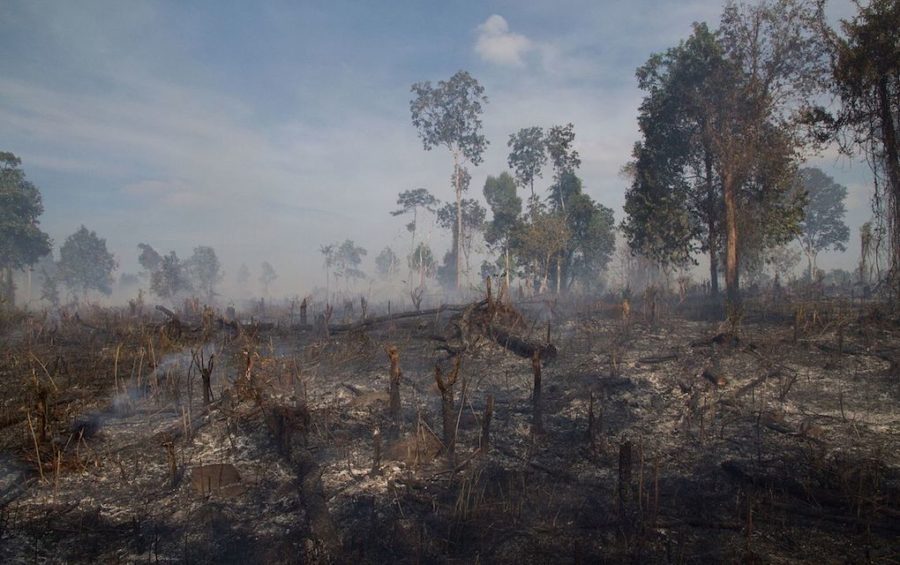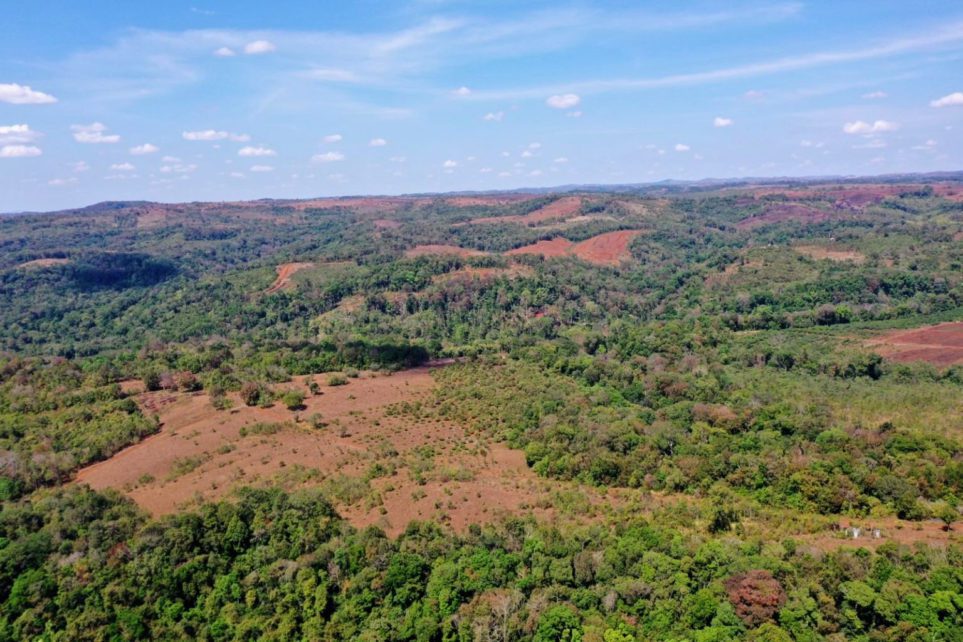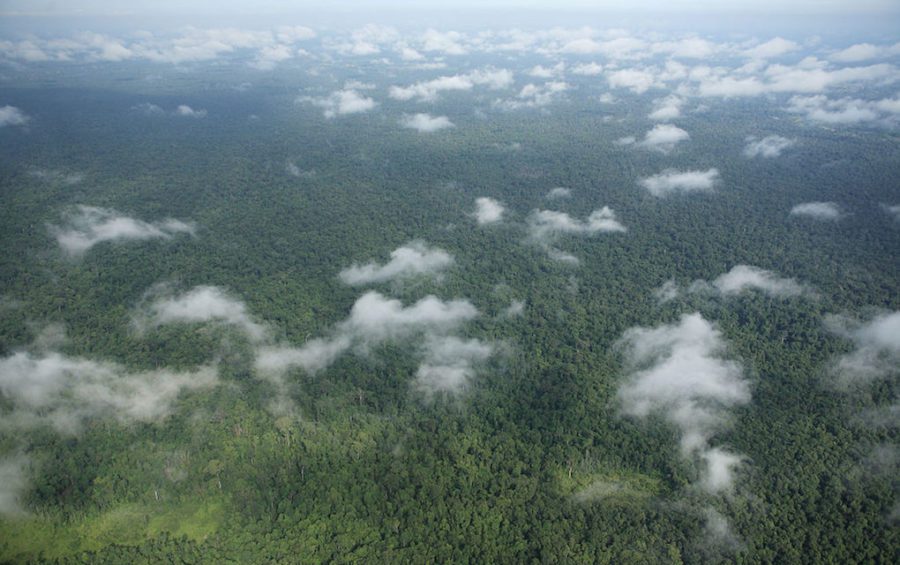UPDATED Nov. 16—Cambodia aspires to reduce 42 percent of its expected 2030 emissions not through stopping coal-powered energy but with trees. More specifically, the country will offset a majority of the total emissions it releases through Redd+, a system where — in its simplest explanation — polluters pay to protect forests that can absorb greenhouse gases to make up for the emissions they put into the atmosphere.
However, counting credits under Redd+ is complex and not always consistent, which is one of the big issues up for debate within Cambodia and globally at COP26.
VOD asked two technical advisers on Cambodia-based Redd+ projects for insight on the system, with the hope of shedding some light for both readers and this reporter.
Meanwhile, Cambodia’s deforestation has increased rapidly in recent years, and activists and watchdogs have pointed out flaws with existing and planned Redd+ projects. Researchers warn that deforestation is progressing too quickly, and Redd+ paints a false picture of the damage that’s been done.
What Is Redd+?
Redd+, or reducing deforestation and forest degradation, creates funds for forest conservation and protection by asking companies to offset their emissions by investing in the thing that can absorb emissions: forests. This is largely done through a voluntary carbon market, where projects advertise their credits and buyers can make a one-time purchase, sometimes with the help of brokers. Some of the Redd+ credits are sold to companies required to regulate their carbon, such as those under a mandatory regulatory regime in Japan.
What Is Cambodia’s Involvement?
Cambodia has Redd+ projects that are actively selling carbon credits to investors, usually private companies, including the Keo Seima Wildlife Sanctuary in Mondulkiri province and the Southern Cardamoms in Koh Kong, managed by conservation NGOs Wildlife Conservation Society and Wildlife Alliance, respectively.
The Tumring Redd+ project in Kampong Thom province, on the edge of the Prey Lang extended forest landscape, was registered but it’s unclear if credits had been purchased yet. Others are preparing to sell carbon credits, usually with corporate or donor support, like the Prey Lang Wildlife Sanctuary Redd+ planned across the territory.
The country is also working on a Redd+ strategy and preparing to centralize all Redd+ projects so that there is at least a standardized accounting system for all projects within the borders. When that’s created, the existing and upcoming projects will fall under Cambodia’s blanket system. That will also make it easier to quantify Cambodia’s emission reductions.

What Are the Benefits?
As one of the participants in the U.N. climate talks, Cambodia also makes an inventory of its emissions and sets a goal to reduce them. Given the country emits very little greenhouse gases compared to the world’s mega polluters — 0.02 percent of the global share — Cambodia hopes to earn more money from private corporations like Delta, Shell and Disney, who have already bought carbon credits in the country. That money can be used to prevent future deforestation, preserve what remains and reforest.
How Are Redd+ Credits Measured?
Satellite imagery of actual deforestation is compared to how much tree cover was expected to be lost without conservation efforts.
Olly Griffin, forest carbon technical adviser for WCS, which oversees the Keo Seima Redd+, said: “Since the beginning of the project in 2010, the activities of KSWS REDD+ have consistently resulted in less deforestation than this without-project scenario.”
Credits are verified and validated by a third-party organization with approved technical capability, and at this time Cambodia does not have any organization registered to do that, so foreign technical experts evaluate the forests.
What Happens If Forests Are Lost?
Purchased credits are still counted as offsetting emissions even if forest protection fails. However, Redd+ projects go through periodic validation, and they must keep unsold credits on hand to offset any potential deforestation.
Aya Uraguchi, technical director for Conservation International, the group that helps manage Prey Lang’s Redd+ project, said: “A credit represents a permanent, verified reduction in emissions, and does not ‘degrade’ in and of itself. There are two main ‘insurance policies’ that ensure that the emission reduction cannot be ‘reversed’ if the forest is destroyed or degraded: safeguards and buffers.”
Safeguards refer to investments that try to deter logging, like supporting communities to run patrols or harvest honey and other goods to sell for their livelihoods instead of cutting wood.
Buffers are spare carbon credits, withheld from the market so that there is no “shortage” of carbon-holding forest if deforestation increases.
What Still Needs to Happen?
In order for carbon credits from various offsetting programs to be exchanged by governments on an official marketplace, the parties at COP26 need to finalize Article 6, a technical debate that would set the rulebook for the global carbon marketplace and ensure that carbon credits are counted fairly and smoothly. Article 6 is important as it’s seen as a way to stabilize the carbon credit marketplace as it has only been voluntary to this point, but one of the ongoing debates has been whether Redd+ carbon credits would even be incorporated in the global marketplace.

What Is an NDC?
As one of the 197 parties participating in the ongoing U.N. climate talks, Cambodia submits a summary of its greenhouse gas emissions and their goals for helping the world limit emissions further, called a Nationally Determined Contribution, or NDC.
In these documents, Cambodia outlines a calculation of how much greenhouse gases the country emits, broken down by sector but excluding corporate emissions. It then submits a goal for how it will help the world limit the global temperature rise to 1.5 degrees Celsius, which scientists have deemed a critical goal in order to prevent the worst climate disasters. Countries also describe how they are adapting to present climate change disasters, their need for international finance in order to reach emissions reductions goals, and other global development aspects like gender equity and education.
Cambodia explained in its 2020 NDC update that it would aspire to cut 64.6 million tons of carbon dioxide equivalent from its projected total 2030 emissions of 154.9 million tons. Most of these cuts — 59 percent of the removed carbon — would come from the forests and land use sector, as it would be offset by Redd+ projects, according to the country plans.
What Are Some Concerns?
Countries report their own emissions and goals, but it’s simply an estimate, and by The Washington Post’s calculations, the globe is underreporting its data by as much as 13.3 billion tons of emissions annually, about equal to that of the world’s heftiest greenhouse gas emitter, China.
Courtney Work, an associate professor at Taiwan’s National Chengchi University who’s written numerous studies of indigenous culture, forest defenders and industrialized logging within the Prey Lang landscape, said she felt Cambodia’s ambitions of reducing heavyweight emissions with Redd+ were “pure fiction.”
She noted that the existing Redd+ projects on the market were also home to problematic developments like power lines, plantations, hydropower dams and ecotourism resorts that can reduce forests and their potential to absorb carbon.
The country also counts plantations, which do little to absorb carbon dioxide compared to dense forest, as part of its forest cover, which calls Cambodia’s accounting into question.
“Carbon accounting is slippery at best,” she said. “Highly inaccurate and different ‘accountants’ count different things and measure captured carbon in different ways.”
Work also criticized the idea of comparing to a “baseline” scenario, in which there were no protection activities at all, saying it creates a false floor to elevate conservation achievements.
“They project massive deforestation in an area, and then when it’s a little less than massive, with the project having little or no impact on deforestation — just ‘natural’ settlement patterns — they claim success. It’s ludicrous,” she said.
She pointed to satellite imagery of the Tumring Redd+ site, which has shown minimal forest cover, especially in recent years, and thus would have little potential as a carbon sink.
The biggest threat to Redd+ projects was that the protection itself by government-employed rangers was corrupted, with rangers ignoring or allowing loggers while blocking patrollers who point out deforestation. USAID’s decision to redistribute funds away from government rangers should have been a sign of the issue, she said.
“The forest might be better protected if MoE rangers were removed entirely. They are consistently facilitating illegal trade and blocking all who try to enter, except the loggers.”
Just because the money comes in doesn’t mean it’s being used effectively: In 2018, the U.K.-based Virgin Airlines stopped buying carbon credits from a Redd+ project in Oddar Meanchey over concerns that deforestation had increased during the project’s timespan. Being a U.K.-based firm, the company was only alerted of this worrying trend by an environmental organization’s investigative report.
Heng Kimhong, research and advocacy head for Cambodia Youth Network, told VOD this week that it’s known there is a serious deforestation problem in the country, and it should make buyers question a Redd+ plan with the government’s involvement: “They have no commitment and have a lot of corruption that happens in local [government], and it affects the situation.”
UPDATED Nov. 16 3:40 p.m.: The “What is Redd+” section was updated to clarify that not all carbon markets are voluntary, as Japan has a compliance market.












